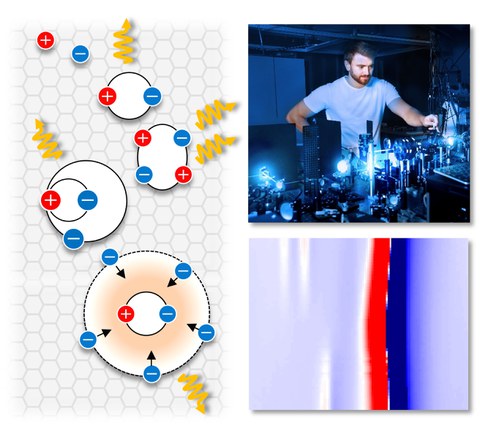Excitonic light emitters
Among main consequences of electronic interactions is the formation of new quasiparticle states. In semiconductors, free electron-hole pairs form tightly bound complexes commonly known as excitons. For systems with strong Coulomb coupling, such as atomically-thin materials, the excitons are exceptionally robust and can sustain both high temperature and high density conditions. Bright excitons dominate the optical response and are predominantly responsible for the light emission, while dark states provide long-lived reservoirs for spin-valley polarization. Moreover, excitons offer a variety of many-particle complexes, including excitonic molecules, charged excitons or Fermi polarons. They also exhibit correlated phenomena such as superfluidity, condensation, and ring formation. In artificially designed heterostructures excitons can drastically change their properties or even form topological states in twisted bilayer systems.
Our aim is to understand and control excitonic many-body states in nanoscale materials. We explore both fundamental properties [1] of the excitons and their behavior under external stimuli such as electrical [2], optical [3] or magnetic [4] fields. In our focus are excitonic complexes such as trions/Fermi polarons [5], exciton-exciton [6] and exciton-phonon [7] scattering dynamics, as well as high-density phenomena up to the Mott transition [8].
[1] G. Wang et al. Rev. Mod. Phys. 90, 021001 (2018) https://doi.org/10.1103/RevModPhys.90.021001
[2] A. Chernikov & A. van der Zande et al. Phys. Rev. Lett. 115, 126802 (2015) https://doi.org/10.1103/PhysRevLett.115.126802
[3] C. Ruppert & A. Chernikov et al. Nano Letters 17, 644 (2017) https://doi.org/10.1021/acs.nanolett.6b03513
[4] J. Zipfel et al. Phys. Rev. B 98, 075438 (2018) https://doi.org/10.1103/PhysRevB.98.075438
[5] K. Wagner & E. Wietek et al. Phys. Rev. Lett. 125, 267401 (2020) https://doi.org/10.1103/PhysRevLett.125.267401
[6] M. Kulig & J. Zipfel et al. Phys. Rev. Lett. 120, 207401 (2018) https://doi.org/10.1103/PhysRevLett.120.207401
[7] A. Raja et al. Nano Lett. 18, 6135 (2018) https://doi.org/10.1021/acs.nanolett.8b01793
[8] A. Chernikov & C. Ruppert et al. Nature Photon., 9, 466 (2015) https://doi.org/10.1038/nphoton.2015.104

